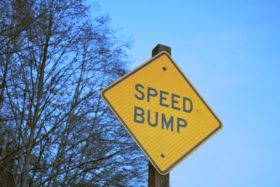Do Speed Bumps & Speed Humps Work?

Speeding is a major safety issue on the roads. In the state of Michigan alone, 24,555 car crashes in 2021 involved speeding. Additionally, excessive speed was cited as being a factor in 21% of fatalities in and 15.5% of suspected serious injuries in Michigan motor vehicle accidents the same year. In the time since the COVID-19 pandemic hit, car accident fatalities increased nationwide, even when people were driving significantly less, a trend which many traffic safety authorities tied to an increase in risky driving behaviors like extreme speeding.
Whether it’s on a residential side street, on an interstate, or in a parking lot, it’s always important for drivers to be aware of the speed limit. When speeding becomes too frequent of a problem, speed bumps or speed humps may be installed to encourage drivers to be more mindful of their speed. But do they really work?
Speed Bumps vs. Speed Humps
Speed bumps and speed humps are similar traffic control measures, but there are distinctions between the two.
Speed bumps are typically 3-5 inches in height and cars can pass over them rather quickly, even when driving at a reduced speed. If a person drives a car over a speed bump too quickly, the occupants of the car will feel a strong bounce. In some cases, driving too fast over a speed bump can damage a vehicle.
Speed humps, on the other hand, have a more subtle design. The highest point of a seed hump isn’t as high as a speed bump, but it’s longer in design. If a person drives over a speed hump at a safe speed, they’ll simply feel a rocking motion in the car. But if a speeding driver crosses a speed hump, it will be more uncomfortable for people inside the vehicle.
Are Speed Bumps & Humps Effective?
One of the key benefits that speed bumps and speed humps have to offer is that they force drivers to be aware of their speed. It’s much harder for drivers to ignore a speed bump than it is for them to ignore something like a sign reminding drivers to slow down. Even if a person routinely drives on a street with speed bumps or humps installed, they’re less likely to zone out and forget about the bumps in the road.
Speed bumps and humps aren’t ideal for all situations, but they can be effective in some locations. Generally speaking, these are best suited for streets with lower speed limits, 35 MPH or less, and for roads that don’t have shoulders where drivers could try and drive around the bump in the road. Because of this, you’re most likely to see speed humps on residential side streets, in school zones, and near playgrounds where it’s likely children are in the area. Since speed bumps force drivers to reduce their speed so drastically, usually to just a few miles per hour, they’re mostly limited to areas like parking lots and private driveways.
Contact a Michigan Car Accident Lawyer
Even though many drivers like to drive fast, car accidents that involve speeding can result in some very serious injuries. If you’ve been injured by a speeding driver, don’t hesitate to contact a car accident lawyer for help with your case. It’s important to have someone on your side who knows the law and can fight to make sure you get the justice you deserve. At Scott Goodwin Law P.C., you’ll be able to speak to a lawyer experienced in helping the victims of Michigan car accidents. Contact us today to schedule a free consultation.
Image: Pixabay / Trevor205






